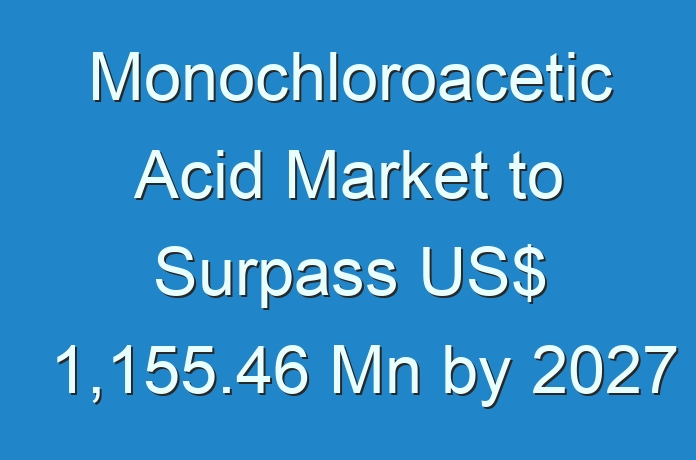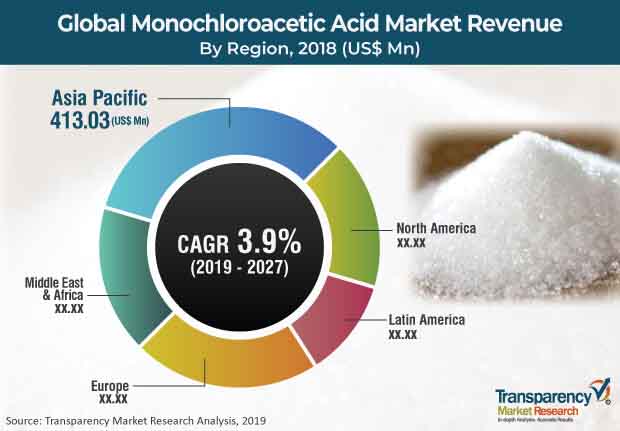
Monochloroacetic Acid Market – Snapshot
Monochloroacetic acid is an intermediate for diverse chemical products. It is a colorless crystalline material formed by chlorinating acetic acid in the presence of catalyst. The alternative method of production entails hydrolysis of trichloroethene using sulfuric acid. It is highly soluble in water and in most of organic solvents, except carbon tetrachloride. Monochloroacetic acid is available in three crystal modifications: alpha, beta, and gamma. Commercially, monochloroacetic acid is produced in the alpha form and is available as flakes, which are water soluble in nature. In terms of product, monochloroacetic acid is used in three forms: flakes, crystalline and liquid. The usage of monochloroacetic acid in the form of flakes is anticipated to rise during the forecast period, due to its purity. Monochloroacetic acid is primarily employed in the production of carboxymethyl cellulose, herbicides, and thioglycolic acid, which are further used in the manufacture of plastics, pharmaceuticals, flavors, cosmetics, and other organic chemicals.
Monochloroacetic acid is primarily used in the manufacture of carboxymethyl cellulose. Carboxymethyl cellulose is a water-soluble cellulose ether, which is used as a thickening agent in aqueous systems. Monochloroacetic acid is employed as a raw material in the production of thioglycolic acid, which is further used as stabilizer for polyvinyl chloride. Monochloroacetic acid is also employed in the manufacture of crop-protection chemicals such as phenoxyacetic acid herbicide; 2, 4 dichlorophenoxyacetic acid also known as 2, 4-D; and 2-methyl-4-chlorophenoxyacetic acid also known as MCPA. Monochloroacetic acid is extensively used in the manufacture of amphoteric surfactants such as betaines and imidazolines. Betaines are progressively being used in the manufacture of liquid soaps and metal cleaning agents. Imidazolines are used as shampoos and industrial cleaners. Monochloroacetic acid is also employed in the manufacture of ibuprofen, diclofenac sodium, caffeine, vitamin B6, glycine, and malonates. Additionally, monochloroacetic acid is used to produce chemicals, such as coumarin, mercaptoacetic acid, aminoacetic acid, cyanoacetic acid, chloroacetamide, and malonic acid. Monochloroacetic acid is extensively employed in the production of glycines, which are further used in the production of pet food, flavoring agents, and medicines such as aspirin.

Request A Sample – https://www.transparencymarketresearch.com/sample/sample.php?flag=S&rep_id=2946
Growth in Oil & Gas Sector to Boost Monochloroacetic Acid Market
The usage of different types of drilling for oil and gas extraction, such as horizontal and directional drilling, has increased due to the technological advancements. This has boosted the usage of various types of drilling equipment. Increase in demand for crude oil and natural gas is also encouraging Exploration and Production (E&P) firms to engage in extensive drilling activities. The global monochloroacetic acid market is projected to expand significantly during the forecast period owing to the rise in drilling activities in land and offshore rigs. Thus, rise in demand for carboxymethyl cellulose in oil and gas drilling activities is driving the monochloroacetic acid market.
Growth of the monochloroacetic acid market can be ascribed to the rise in demand for carboxymethyl cellulose, as monochloroacetic acid is used in the manufacturing of carboxymethyl cellulose. Globally, more than 30% of the monochloroacetic acid is used in the production of carboxymethyl cellulose. Carboxymethyl cellulose is used as a viscosifier in drilling muds for drilling of boreholes for the extraction of oil and gas. It balances physical parameters such as viscosity, thus reducing the loss of water and increasing thixotropy of the oil. It also arrests the growth of fungus while drilling mud, thereby terminating the need of preservatives and pH level indicators in the mud. Therefore, demand for monochloroacetic acid is directly proportional to the usage of carboxymethyl cellulose in oil exploration and rig drilling activities.
More Trending Reports by Transparency Market Research – https://www.prnewswire.com/news-releases/overwhelming-properties-to-invite-extensive-growth-for-textile-chemicals-market-across-forecast-period-of-2019-2027-tmr-301176937.html
Leading Players Focusing on Geographical Expansion
Key players profiled in the global monochloroacetic acid market include AkzoNobel N.V., CABB GmbH, Shandong Minji Chemical Co., Ltd., PCC SE, Denak Co. Ltd., Niacet Corporation, and Jubilant Life Sciences Limited. These players engage in collaborations, mergers & acquisitions (M&A), geographical expansion, and launch of new products. On August 2018, PCC monochloroacetic acidA Sp. z o. o, a subsidiary of PCC SE, announced plans to expand its production of monochloroacetic acid from 42,000 tons to 100,000 tons per year. This move is expected to help the company cater to the rise in demand for monochloroacetic acid in North and South America, and Asia. The company offers monochloroacetic acid ranging from technical grade to high purity and ultra-clean grades.
Carboxymethyl Cellulose Segment to Dominate Monochloroacetic Acid Market
Carboxymethyl cellulose is an anionic water-soluble polymer obtained from cellulose. It possesses excellent thickening, absorption, and water retention properties. Carboxymethyl cellulose possesses properties such as high viscosity and non-toxic nature. It is also hypoallergenic. Carboxymethyl cellulose is widely used as thickener, stabilizer, binder, and dispersant in various applications such as food, pharmaceutical, cosmetics, detergents, and oil & gas. Therefore, carboxymethyl cellulose is extensively used in oil & gas exploration. It is also used as viscosifier for drilling boreholes for the extraction of oil & gas and rig drilling activities.
Request for Discount on This Report at – https://www.transparencymarketresearch.com/sample/sample.php?flag=D&rep_id=2946
Emerging Economies Dominating Monochloroacetic Acid Market
In terms of value, Asia Pacific was the leading region of the global monochloroacetic acid market in 2018, followed by Europe. The global monochloroacetic acid market is primarily driven by China, owing to the increase in industrialization in the country. In terms of consumption, China accounted for 50% share the global monochloroacetic acid market in 2018. Monochloroacetic acid is extensively used to manufacture carboxymethyl cellulose in Europe. However, the use of carboxymethyl cellulose has declined in the last few years due to the closure of plants in the region owing to fluctuation in prices of raw materials. This, in turn, has adversely affected the demand for monochloroacetic acid in Europe. The market in North America is projected to expand at a steady pace during the forecast period. The market in Latin America is anticipated to expand at a substantial pace during the forecast period owing to high demand for agrochemicals and carboxymethyl cellulose in Brazil. Furthermore, rise in activities such as oil & gas exploration and expansion in the agrochemicals industry are fuelling the demand for monochloroacetic acid. Increase in iron ore and taconite mining activities is providing opportunities for the global monochloroacetic acid market. Carboxymethyl cellulose is used in iron ore pelletization, froth flotation, and tailings flocculation. During processing of gangue depressant, small dosage of carboxymethyl cellulose is used for deactivating undesired impurities in minerals. Thus, carboxymethyl cellulose help by mining out high quantity of minerals and metals during exploration.
Request for covid19 Impact Analysis – https://www.transparencymarketresearch.com/sample/sample.php?flag=covid19&rep_id=2946





